
Catalog excerpts
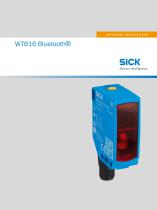
OPERATING INSTRUCTIONS SICK Sensor Intelligence.
Open the catalog to page 1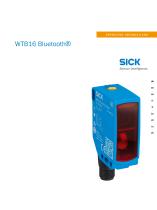
OPERATING INSTRUCTIONS
Open the catalog to page 2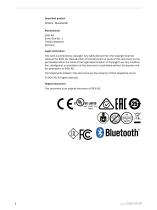
Described product WTB16 - Bluetooth® Manufacturer SICK AG Erwin-Sick-Str. 1 79183 Waldkirch Germany Legal information This work is protected by copyright. Any rights derived from the copyright shall be reserved for SICK AG. Reproduction of this document or parts of this document is only permissible within the limits of the legal determination of Copyright Law. Any modifica‐ tion, abridgment or translation of this document is prohibited without the express writ‐ ten permission of SICK AG. The trademarks stated in this document are the property of their respective owner. © SICK AG. All rights...
Open the catalog to page 3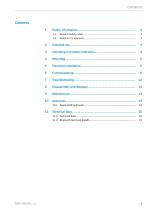
J022691.10DR | SICK ;upject to change without notice
Open the catalog to page 4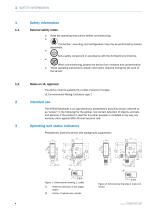
Safety information General safety notes Read the operating instructions before commissioning. Connection, mounting, and configuration may only be performed by trained specialists. ■ Not a safety component in accordance with the EU Machinery Directive. When commissioning, protect the device from moisture and contamination. These operating instructions contain information required during the life cycle of the sensor. Notes on UL approval The device must be supplied by a Class 2 source of supply. UL Environmental Rating: Enclosure type 1 Intended use The WTB16 Bluetooth is an opto-electronic...
Open the catalog to page 5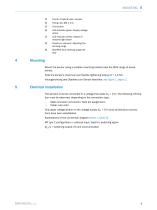
@ Center of optical axis, receiver © LED indicator green: Supply voltage active 7 LED indicator yellow: Status of received light beam © Press-turn element: Adjusting the sensing range ® BluePilot blue: Sensing range dis Mount the sensor using a suitable mounting bracket (see the SICK range of accessories). Note the sensor's maximum permissible tightening torque of < 1,3 Nm. Vorzugsrichtung des Objektes zum Sensor beachten, see figure 1, figure 2. 5 Electrical installation The sensors must be connected in a voltage-free state (UV = 0 V). The following information must be observed, depending...
Open the catalog to page 6
Table 2: Push / pull 8022691.10DR | SICK Subject to change without notice
Open the catalog to page 7
Alignment WTB16P Bluetooth®: Align sensor on object. Select the position so that the red emitted light beam hits the center of the object. You must ensure that the optical opening (front screen) of the sensor is completely clear [see figure 3, see figure 4]. WTB16I Bluetooth®: Align sensor on object. Select the position so that the infrared light (not visible) hits the center of the object. The correct alignment can only be detected via the LED indicators. see figure 3, figure 4 , see table 1, see table 2. You must ensure that the optical opening (front screen) of the sensor is completely...
Open the catalog to page 8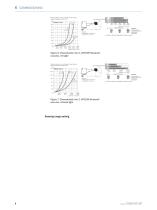
Example: Sensing range on black, 6%, A = Detection distance (depending on object remission) BluePilot; Sensing range indicator (blue LED) Teach-Turn adjustment A = Detection distance (depending on object remission) BluePilot; Sensing range indicator (blue LED) Teach-Turn adjustment Sensing range setting 8022691.10DR | SICK Subject to change without notice 8
Open the catalog to page 9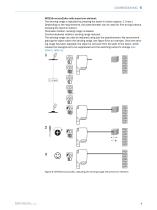
COMMISSIONING 6 WTB16x-xxxxxx2xAxx with press-turn element: The sensing range is adjusted by pressing the teach-in button (approx. 1-3 sec.). Depending on the requirements, the potentiometer can be used for fine-tuning (without pressing the teach-in button). Clockwise rotation: sensing range increased. Counterclockwise rotation: sensing range reduced. The sensing range can also be adjusted using just the potentiometer. We recommend placing the object within the sensing range, see figure 8 for an example. Once the sens‐ ing range has been adjusted, the object is removed from the path of the...
Open the catalog to page 10
6 COMMISSIONING WTB16x-xxxxxx1xAxx with potentiometer: The sensing range is adjusted with the potentiometer. Clockwise rotation: sensing range increased. Counterclockwise rotation: sensing range reduced. We recommend placing the object within the sensing range, see figure 9 for an exam‐ ple. Once the sensing range has been adjusted, the object is removed from the path of the beam, which causes the background to be suppressed and the switching output to change (see table 1, table 2). Figure 9: WTB16x-xxxxxx1xAxx, adjusting the sensing range with potentiometer 8022691.10DR | SICK Subject to...
Open the catalog to page 11
COMMISSIONING 6 WTB16x-xxxxxx3xAxx with teach-in button: The sensing range is adjusted by pressing the teach-in button (approx. 1-3 sec.). We recommend placing the object within the sensing range, see figure 10 for an example. Once the sensing range has been adjusted, the object is removed from the path of the beam, which causes the background to be suppressed and the switching output to change (see table 1, table 2). Figure 10: WTB16x-xxxxxx3xAxx, adjusting the sensing range with teach-in button 8022691.10DR | SICK Subject to change without notice
Open the catalog to page 12
Process data structure (Version 1.1) 8022691.10DR | SICK Subject to change without notice
Open the catalog to page 13
Disassembly and disposal The sensor must be disposed of according to the applicable country-specific regulations. Efforts should be made during the disposal process to recycle the constituent materials (particularly precious metals). NOTE Disposal of batteries, electric and electronic devices • According to international directives, batteries, accumulators and electrical or electronic devices must not be disposed of in general waste. • The owner is obliged by law to return this devices at the end of their life to the respective public collection points. This symbol on the product, its...
Open the catalog to page 14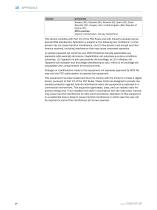
This device complies with Part 15 of the FCC Rules and with Industry Canada licence-exempt RSS standard(s). Operation is subject to the following two conditions: (1) this device may not cause harmful interference, and (2) this device must accept any interference received, including interference that may cause undesired operation. Le present appareil est conforme aux CNR d'Industrie Canada applicables aux appareils radio exempts de licence. L'exploitation est autorisee aux deux conditions suivantes: (1) l'appareil ne doit pas produire de brouillage, et (2) l'utilisateur de l'appareil doit...
Open the catalog to page 15All SICK SENSOR INTELLIGENCE catalogs and technical brochures
-
REGISTRATION SENSORS
24 Pages
-
CLV63x, CLV64x, CLV65x
102 Pages
-
WE9LC-3_A71
3 Pages
-
Safety Switches
20 Pages
-
Automation light grids
8 Pages
-
Encoders and Inclination Sensors
32 Pages
-
Proximity Sensors
324 Pages
-
Dust measuring devices
172 Pages
-
Detection and Ranging Solutions
124 Pages
-
Distance Sensors
404 Pages
-
Vision
124 Pages
-
Top-Products from SICK
556 Pages
-
Fluid Sensors
243 Pages
-
Registration Sensors
276 Pages
-
Magnetic Cylinder Sensors
164 Pages
-
IDENTIFICATION SOLUTIONS
24 Pages
-
Our identification solutions
8 Pages
-
FLOWSIC300 Ultrasonic Gas Flow Meter
177 Pages
-
FLOWSIC300 Gas flow meters
12 Pages
-
FLOWSIC500 Gas flow meters
16 Pages
-
FLOWSIC600 Ultrasonic Gas Flow Meter
138 Pages
-
FLOWSIC600 Gas Flow Meter
16 Pages
-
ConVer
12 Pages
-
GM32 In-situ gas analyzers
28 Pages
-
GM35 In-Situ IR Gas Analyzer
16 Pages
-
Encoders
788 Pages
-
Opto Electronic Protective Devices
712 Pages
-
GMS800 Extractive Gas Analyzers
20 Pages
-
WT100-2 energetic
47 Pages
-
VPS Pro Profiling systems
20 Pages
-
Photoelectric Sensors
949 Pages
-
G6 - Global Sensor
20 Pages
-
Hand-Held Scanners IDMx
48 Pages














































